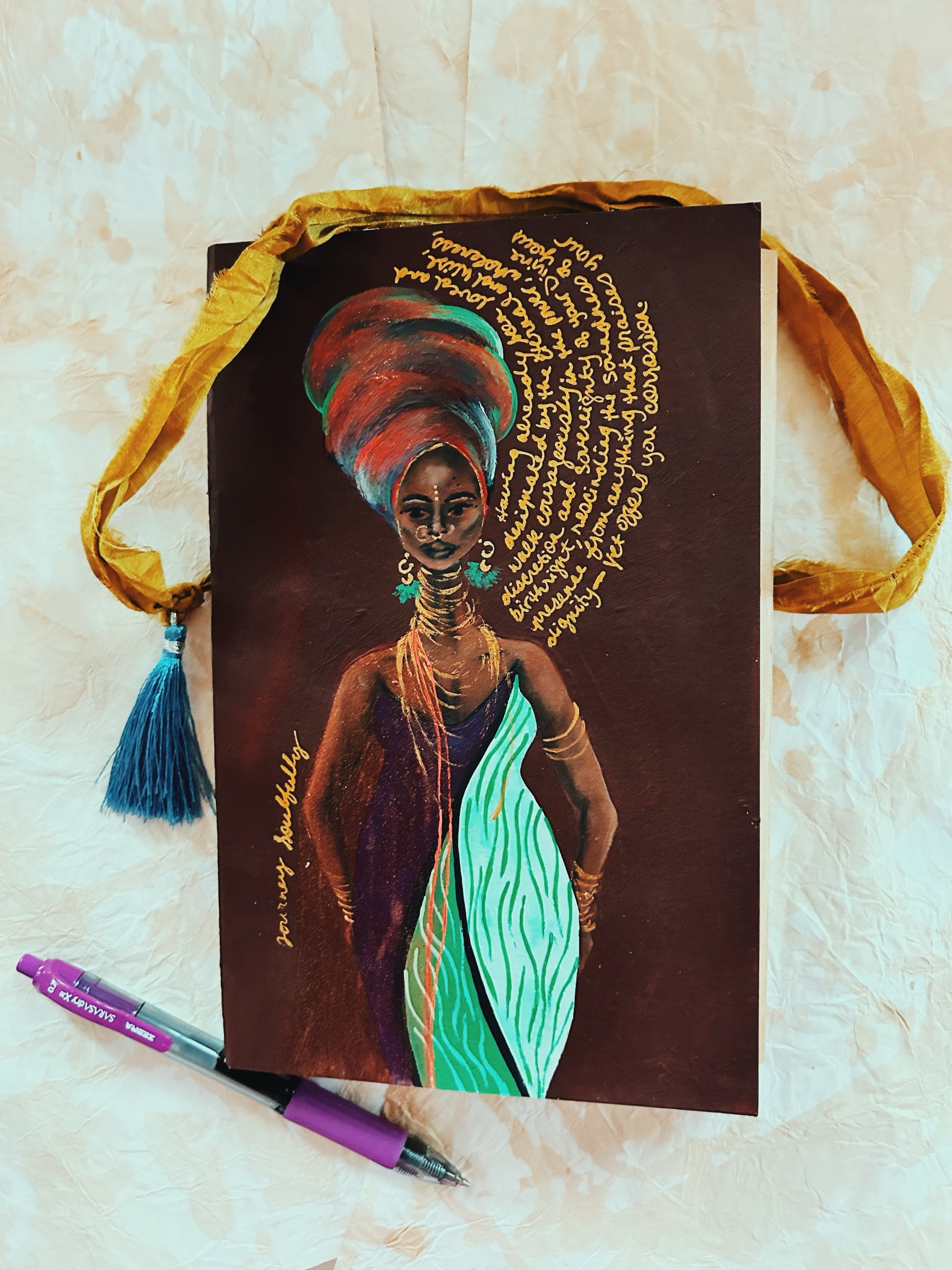 Image 1 of
Image 1 of


“…walk courageously in the power, wholeness…”
“Having already been loved and designated by the Eternal and Wise, walk courageously in the power, wholeness, discretion and sovereignty of your Divine birthright, rescinding the soundness of your presence from anything that praises your dignity— yet offers you corrosion.”
info:
73 teastained pages
acrylic and gouache on coverstock
saree ribbon
silk tassel
Queens and servants, sojourners and prophetesses—all wear garments that indicate who they are: what they’ve been bred to be. Garments represent achieved process or change of life. They represent the season of a journey now completed; arrival to a new lifecycle; acceptanxe and operation in a mandate that has its own uniform.
In everyday life when we change clothes it’s an indication to others that we’re about to take a new course of action: fix dinner, go out for the evening (little black dress), workout (gym shorts), turn in for the night (hair bonnet and PJs), etc. However in a weightier sense, when we have spiritually changed our garments it’s displayed in the jokes we nolonger laugh at, the causes we nolonger support, the new focus we have, the TV shows we don’t watch, the parties we don’t attend, and the new way we think and speak. When we have spiritually changed our garments we ade signifying to ourselves and to others thay we have abandoned an old way of being.
Change your garments. Sing a new song. Joyful beings don’t wear mourner’s rags, Queens don’t wear peasant’s robes and prophetesses don’f dress like those who don’t hear from the Most High. Elder matriarchs wear garments that tell parting crowds their seen and unseen role in their family and community.
Garments trll stories and create narratives. They indicate culture and rank. When your life changes so do your spirit and soul’s garments. Dressing outside of your function is not an option when you are on this journey. Change your mind, change your spirit’s clothes too.
much love and regeneration be yours
Chimene
“Having already been loved and designated by the Eternal and Wise, walk courageously in the power, wholeness, discretion and sovereignty of your Divine birthright, rescinding the soundness of your presence from anything that praises your dignity— yet offers you corrosion.”
info:
73 teastained pages
acrylic and gouache on coverstock
saree ribbon
silk tassel
Queens and servants, sojourners and prophetesses—all wear garments that indicate who they are: what they’ve been bred to be. Garments represent achieved process or change of life. They represent the season of a journey now completed; arrival to a new lifecycle; acceptanxe and operation in a mandate that has its own uniform.
In everyday life when we change clothes it’s an indication to others that we’re about to take a new course of action: fix dinner, go out for the evening (little black dress), workout (gym shorts), turn in for the night (hair bonnet and PJs), etc. However in a weightier sense, when we have spiritually changed our garments it’s displayed in the jokes we nolonger laugh at, the causes we nolonger support, the new focus we have, the TV shows we don’t watch, the parties we don’t attend, and the new way we think and speak. When we have spiritually changed our garments we ade signifying to ourselves and to others thay we have abandoned an old way of being.
Change your garments. Sing a new song. Joyful beings don’t wear mourner’s rags, Queens don’t wear peasant’s robes and prophetesses don’f dress like those who don’t hear from the Most High. Elder matriarchs wear garments that tell parting crowds their seen and unseen role in their family and community.
Garments trll stories and create narratives. They indicate culture and rank. When your life changes so do your spirit and soul’s garments. Dressing outside of your function is not an option when you are on this journey. Change your mind, change your spirit’s clothes too.
much love and regeneration be yours
Chimene
“Having already been loved and designated by the Eternal and Wise, walk courageously in the power, wholeness, discretion and sovereignty of your Divine birthright, rescinding the soundness of your presence from anything that praises your dignity— yet offers you corrosion.”
info:
73 teastained pages
acrylic and gouache on coverstock
saree ribbon
silk tassel
Queens and servants, sojourners and prophetesses—all wear garments that indicate who they are: what they’ve been bred to be. Garments represent achieved process or change of life. They represent the season of a journey now completed; arrival to a new lifecycle; acceptanxe and operation in a mandate that has its own uniform.
In everyday life when we change clothes it’s an indication to others that we’re about to take a new course of action: fix dinner, go out for the evening (little black dress), workout (gym shorts), turn in for the night (hair bonnet and PJs), etc. However in a weightier sense, when we have spiritually changed our garments it’s displayed in the jokes we nolonger laugh at, the causes we nolonger support, the new focus we have, the TV shows we don’t watch, the parties we don’t attend, and the new way we think and speak. When we have spiritually changed our garments we ade signifying to ourselves and to others thay we have abandoned an old way of being.
Change your garments. Sing a new song. Joyful beings don’t wear mourner’s rags, Queens don’t wear peasant’s robes and prophetesses don’f dress like those who don’t hear from the Most High. Elder matriarchs wear garments that tell parting crowds their seen and unseen role in their family and community.
Garments trll stories and create narratives. They indicate culture and rank. When your life changes so do your spirit and soul’s garments. Dressing outside of your function is not an option when you are on this journey. Change your mind, change your spirit’s clothes too.
much love and regeneration be yours
Chimene
